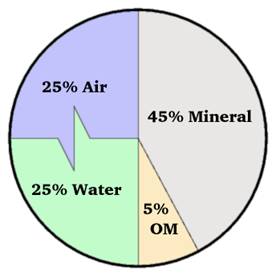|
The thought of needing to rebuild urban soils probably strikes most of you reading this a funny at best and a waste of time at worst. What possible reason could you have for rebuilding urban soils, you are not a farmer or rancher why should you care about the quality of the soil underneath your feet. Well the simple reason for this is that soil is quite literally what everything is built upon and I know that is a bit tongue and cheek but it is still true. I don't just mean the literal built upon like a building on a foundation but also the web of life that supports life as we know it is also built upon the soil at our feet. Now in the grand scheme of things I will concede that the soil quality out on farms and ranches might be more important than the one in your front yard but that doesnt mean the soil there isn't important. 
What is Soil?
I just wanted to offer a quick recap in case you are not exactly sure what soil is and what a good one looks like. To start off I will go over the basic components of soil and how those components mix to form a good soil. 4 Components of Soil Soil is made of up the following parts
All these components exist in varying amounts but in a good soil you will find them in the ratio shown in the diagram above. Different types of soil are good for different things, a loam soil is the most favored for agriculture because it ratio of sand, silt and clays to the other components makes it favorable for plant growth. While soils that are higher in sand are typically more prized for building on top of since they drain fast and reduce the risk of flooding and foundation movement. Why Good Urban Soils are Important. To understand why having good urban soils is important we have to look at what happens when you have a bad urban soil. Bad urban soil could be characterized in the following ways,
Soils and Water To really illustrate my point I want to talk about the interaction between soil and water. A healthy soil acts like a sponge and they are much better at dealing with heavy rainfall because they can absorb and drain water faster than a soil that is compacted and has poor structure. In addition to providing a avenue for water a healthy soil is also a great base for plants to grow in which leads to even better soil structure. This dual ability to hold water and provide a strong substrate for plants to anchor in are the most important benefits of good soils in urban communities. Where this really comes into play in communities is managing water after a storm event. With its mixes of impervious surfaces ie. (concrete & asphalt) and soil urban cities present a unique problem of where this water should go. In a rural setting the rain in most cases gets absorbed where it falls but in a urban setting a large percent of the water will runoff because it can't be absorbed. Controlling and directing this water is a big issue for many communities and it can cost thousands to millions of dollars a year. A Example A study conducted by the Trust for Public Lands and American Water Works Association found that for every 10% increase in tree cover there was a 20% decrease in water treatments costs. But this benefit applies the best when the trees are large mature trees and not young saplings. Since the average lifespan of a urban tree is 30 years compared to 150 years in rural areas large mature trees are not as common in urban areas. The reasons behind this lack of large mature trees are many but since this post is about rebuilding urban soils I will stick with the soil issues for now. The urban tree is under constant stress from the poor soil conditions it deals with,
All of these factors can slow a trees growth, reduce its overall vigor, and lead to its premature death. Without large amounts of vigorous plant growth a soil is not as capable of absorbing water and reducing runoff as it could be which leads to increased runoff and the issues associated with it. Treating Poor Urban Soils Almost universally soil can be “rebuilt” by doing two simple things. Adding organic matter a.k.a compost to the area needing treatment And Keeping large equipment and heavy foot traffic out of the area. That’s it well that, some time and the legion of soil organisms that will be doing the real work. The organic matter you added is what really brings a soil back to life. It provides the food source needed by soil organism and plant roots to break up compaction, build soil structure, allow better water infiltration and absorption. This allows the soil to heal and rebuild from the damage inflicted on it when the site was built up. This will happen naturally overtime but you can speed up the process by adding additional compost and in some rare cases tilling or otherwise breaking up the ground. Any mechanical loosing should be kept to the minimum since it leads to more compaction in the long run. For more information like this check out other articles here on the Green Living LIbrary. Sources: https://www.epa.gov/sites/production/files/2015-10/documents/2008_01_02_nps_lid_costs07uments_reducingstormwatercosts-2.pdf https://fhm.fs.fed.us/pubs/fhncs/chapter1/trees_in_cities.htm
0 Comments
Leave a Reply. |
AuthorHello my name is Josh Larson and I am the creator of the Green Living Library. Here on the blog you will find updates to content found in the Green Living Library as well as stories from those living the sustainable life already. Archives
December 2021
Categories
All
|